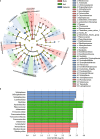Co-occurrence pattern and function prediction of bacterial community in Karst cave
- PMID: 32471344
- PMCID: PMC7257168
- DOI: 10.1186/s12866-020-01806-7
Co-occurrence pattern and function prediction of bacterial community in Karst cave
Abstract
Background: Karst caves are considered as extreme environments with nutrition deficiency, darkness, and oxygen deprivation, and they are also the sources of biodiversity and metabolic pathways. Microorganisms are usually involved in the formation and maintenance of the cave system through various metabolic activities, and are indicators of changes environment influenced by human. Zhijin cave is a typical Karst cave and attracts tourists in China. However, the bacterial diversity and composition of the Karst cave are still unclear. The present study aims to reveal the bacterial diversity and composition in the cave and the potential impact of tourism activities, and better understand the roles and co-occurrence pattern of the bacterial community in the extreme cave habitats.
Results: The bacterial community consisted of the major Proteobacteria, Actinobacteria, and Firmicutes, with Proteobacteria being the predominant phylum in the rock, soil, and stalactite samples. Compositions and specialized bacterial phyla of the bacterial communities were different among different sample types. The highest diversity index was found in the rock samples with a Shannon index of 4.71. Overall, Zhijin cave has relatively lower diversity than that in natural caves. The prediction of function showed that various enzymes, including ribulose-bisphosphate carboxylase, 4-hydroxybutyryl-CoA dehydratase, nitrogenase NifH, and Nitrite reductase, involved in carbon and nitrogen cycles were detected in Zhijin cave. Additionally, the modularity indices of all co-occurrence network were greater than 0.40 and the species interactions were complex across different sample types. Co-occurring positive interactions in the bacteria groups in different phyla were also observed.
Conclusion: These results uncovered that the oligotrophic Zhijin cave maintains the bacterial communities with the diverse metabolic pathways, interdependent and cooperative co-existence patterns. Moreover, as a hotspot for tourism, the composition and diversity of bacterial community are influenced by tourism activities. These afford new insights for further exploring the adaptation of bacteria to extreme environments and the conservation of cave ecosystem.
Keywords: 16S rRNA gene; Bacterial community; Co-occurrence network; Function prediction; Karst; Oligotrophy; Tourism; Zhijin cave.
Conflict of interest statement
The authors declare that they have no competing interests.
Figures





Similar articles
-
Dominant bacterial phyla in caves and their predicted functional roles in C and N cycle.BMC Microbiol. 2017 Apr 11;17(1):90. doi: 10.1186/s12866-017-1002-x. BMC Microbiol. 2017. PMID: 28399822 Free PMC article.
-
The diversity of microbes and prediction of their functions in karst caves under the influence of human tourism activities-a case study of Zhijin Cave in Southwest China.Environ Sci Pollut Res Int. 2022 Apr;29(17):25858-25868. doi: 10.1007/s11356-021-17783-x. Epub 2021 Dec 1. Environ Sci Pollut Res Int. 2022. PMID: 34854002
-
Bacteria and Metabolic Potential in Karst Caves Revealed by Intensive Bacterial Cultivation and Genome Assembly.Appl Environ Microbiol. 2021 Feb 26;87(6):e02440-20. doi: 10.1128/AEM.02440-20. Print 2021 Feb 26. Appl Environ Microbiol. 2021. PMID: 33452024 Free PMC article.
-
The geomicrobiology of limestone, sulfuric acid speleogenetic, and volcanic caves: basic concepts and future perspectives.Front Microbiol. 2024 Mar 20;15:1370520. doi: 10.3389/fmicb.2024.1370520. eCollection 2024. Front Microbiol. 2024. PMID: 38572233 Free PMC article. Review.
-
Taxonomic diversity of extremophilic prokaryotes adapted to special environmental parameters in Hungary: a review.Biol Futur. 2024 Jun;75(2):183-192. doi: 10.1007/s42977-024-00224-4. Epub 2024 May 16. Biol Futur. 2024. PMID: 38753295 Review.
Cited by
-
Competition-cooperation in the chemoautotrophic ecosystem of Movile Cave: first metagenomic approach on sediments.Environ Microbiome. 2022 Aug 17;17(1):44. doi: 10.1186/s40793-022-00438-w. Environ Microbiome. 2022. PMID: 35978381 Free PMC article.
-
Unveiling the Bacterial Community across the Stomach, Hepatopancreas, Anterior Intestine, and Posterior Intestine of Pacific Whiteleg Shrimp.J Microbiol Biotechnol. 2024 Jun 28;34(6):1260-1269. doi: 10.4014/jmb.2403.03039. Epub 2024 Apr 29. J Microbiol Biotechnol. 2024. PMID: 38938005 Free PMC article.
-
Characterization and genomic analysis of a lytic Stenotrophomonas maltophilia short-tailed phage A1432 revealed a new genus of the family Mesyanzhinovviridae.Front Microbiol. 2024 Jun 27;15:1400700. doi: 10.3389/fmicb.2024.1400700. eCollection 2024. Front Microbiol. 2024. PMID: 38993489 Free PMC article.
-
MicNet toolbox: Visualizing and unraveling a microbial network.PLoS One. 2022 Jun 24;17(6):e0259756. doi: 10.1371/journal.pone.0259756. eCollection 2022. PLoS One. 2022. PMID: 35749381 Free PMC article.
-
Ammonia-oxidizing archaea adapted better to the dark, alkaline oligotrophic karst cave than their bacterial counterparts.Front Microbiol. 2024 Apr 10;15:1377721. doi: 10.3389/fmicb.2024.1377721. eCollection 2024. Front Microbiol. 2024. PMID: 38659982 Free PMC article.
References
-
- Rothschild LJ, Mancinelli RL. Life in extreme environments. Nature. 2001;409(6823):1092–1101. - PubMed
-
- Engel Annette Summers. Geomicrobiology: Molecular and Environmental Perspective. Dordrecht: Springer Netherlands; 2010. Microbial Diversity of Cave Ecosystems; pp. 219–238.
-
- Northup DE, Lavoie KH. Geomicrobiology of caves: a review. Geomicrobiol J. 2001;18(3):199–222.
-
- Sarbu SM, Kane TC, Kinkle BK. A chemoautotrophically based cave ecosystem. Science. 1996;272(5270):1953–1955. - PubMed
Publication types
MeSH terms
Substances
Grants and funding
LinkOut - more resources
Full Text Sources

